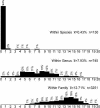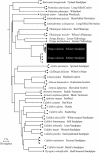Identification of Birds through DNA Barcodes
- PMID: 15455034
- PMCID: PMC518999
- DOI: 10.1371/journal.pbio.0020312
Identification of Birds through DNA Barcodes
Abstract
Short DNA sequences from a standardized region of the genome provide a DNA barcode for identifying species. Compiling a public library of DNA barcodes linked to named specimens could provide a new master key for identifying species, one whose power will rise with increased taxon coverage and with faster, cheaper sequencing. Recent work suggests that sequence diversity in a 648-bp region of the mitochondrial gene, cytochrome c oxidase I (COI), might serve as a DNA barcode for the identification of animal species. This study tested the effectiveness of a COI barcode in discriminating bird species, one of the largest and best-studied vertebrate groups. We determined COI barcodes for 260 species of North American birds and found that distinguishing species was generally straightforward. All species had a different COI barcode(s), and the differences between closely related species were, on average, 18 times higher than the differences within species. Our results identified four probable new species of North American birds, suggesting that a global survey will lead to the recognition of many additional bird species. The finding of large COI sequence differences between, as compared to small differences within, species confirms the effectiveness of COI barcodes for the identification of bird species. This result plus those from other groups of animals imply that a standard screening threshold of sequence difference (10x average intraspecific difference) could speed the discovery of new animal species. The growing evidence for the effectiveness of DNA barcodes as a basis for species identification supports an international exercise that has recently begun to assemble a comprehensive library of COI sequences linked to named specimens.
Conflict of interest statement
The authors have declared that no conflicts of interest exist.
Figures





Comment in
-
DNA barcoding: promise and pitfalls.PLoS Biol. 2004 Oct;2(10):e354. doi: 10.1371/journal.pbio.0020354. Epub 2004 Sep 28. PLoS Biol. 2004. PMID: 15486587 Free PMC article. No abstract available.
References
-
- Ankney CD, Dennis DG, Wishard LN, Seeb JE. Low genic variation between Black Ducks and Mallards. Auk. 1986;103:701–709.
-
- [AOU] The American Ornithologists' Union. Lawrence, Kansas: AOU Press; 1998. Check-list of North American birds, 7th edition; 829 pp.
-
- Avise JC, Zink RM. Molecular genetic divergence between avian sibling species: King and Clapper rails, Long-billed and Short-billed dowitchers, Boated-tailed and Great-tailed grackles, and Tufted and Black-crested titmice. Auk. 1988;105:516–528.
MeSH terms
Substances
LinkOut - more resources
Full Text Sources
Other Literature Sources

